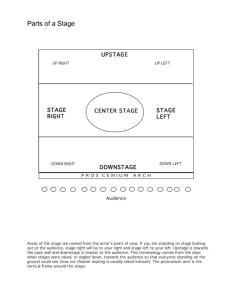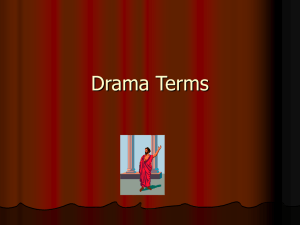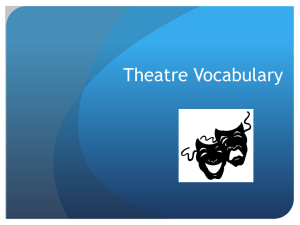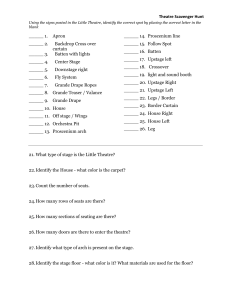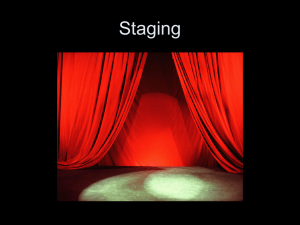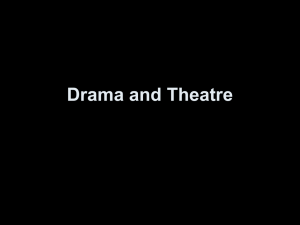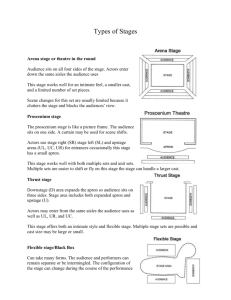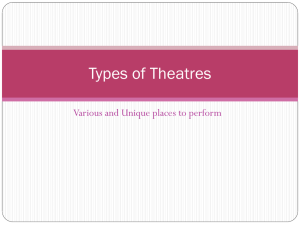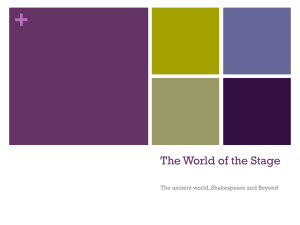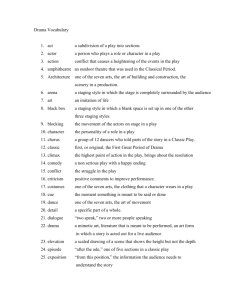Introductiontotheatre
advertisement
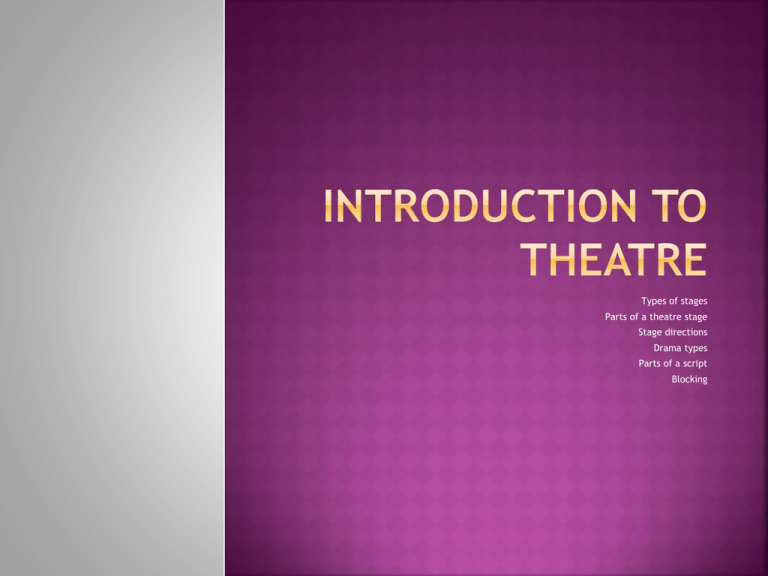
Types of stages Parts of a theatre stage Stage directions Drama types Parts of a script Blocking Proscenium stage Apron: The area of the stage in front of the proscenium arch. Typically not used as a performance space. Crossover: The area used by performers and technicians to travel from stage left to right out of sight of the audience onstage created with masking and drapery. Plaster Line: An imaginary reference line on the playing area that indicates where the proscenium arch is. Typically, the plaster line runs across the stage at the back face (upstage face) of the proscenium wall. Wings: Areas that are part of a stage deck but offstage (out of sight of the audience). The wings are typically masked with legs. Control Booth: Area in which the light and sound crew operate the machines. Cat walk: section of the house hidden in the ceiling from which many of the technical functions of a theatre, such as lighting and sound, may be manipulated Upstage: The area of the stage furthest from the audience. Downstage: The area of the stage closest to the audience. Stage Left: The area of the stage to the performer's left, when facing downstage (i.e. towards the audience). Stage Right: The area of the stage to the performer's right, when facing downstage (i.e. towards the audience). Center Stage: The center of the playing (performance) area. Center Line: An imaginary reference line on the playing area that indicates the exact center of the stage, travelling from up to downstage. Onstage: The portion of the playing area visible to the audience. Offstage: The area surrounding the playing space not visible to the audience. Typically this refers to spaces accessible to the performers but not the audience, such as the wings, crossovers, and voms. Since there are no stage directions as in the proscenium stage actors must be identified in a different manner. Clock references: 12 o’ clock position is assigned then and all other positions are worked out from there. Quadrants: the stage is divided in 4 quadrants named according to compass locations, (NE, SE, SW, NW), numbers (1-4), or letters (A-D) Blocking is a theatre terms that refers to the precise movement and positioning of actors on a stage in order to facilitate the performance of a play. Entering, exiting, crossing, sitting, and standing. Cross: movement from one stage position to another. Countercross: movement in opposite directions by two or more actors to balance the stage picture. Tragedy: a play in which the protagonist fails achieve desired goals or is overcome by opposing forces. Ex. Romeo & Juliet Comedy: a play that treats characters and situations in a humorous way and has a happy ending. Ex. The Importance of Being Earnest Fantasy: a play that deals with unrealistic and fantastic characters. Ex. Wizard of Oz Romantic Comedy: a play that presents a idealized love affair. Ex. Sentimental comedy: eighteenth-century genre that was a reaction to the immortality in Restoration drama Melodrama: plays based on romantic plots that have little regard for convincing motivation or detailed characterization and that have the primary goal of keeping an audience involved using any means. Play of Ideas: deals with a social problem or ethical issue, sometimes presenting a solution. Psychological drama: a play that addresses the complexities of the human psyche and personal relaionships. The “Whoodunit”: a crime solving or courtroom drama Allegory: a form of storytelling that teaches moral concepts by using symbolic characters, events, or objects. Children’s Theatre: theatre written, designed, and performed for children. Puppet theatre: actors use puppets to tell a story Monodrama: a play written to be performed by a single actor.


